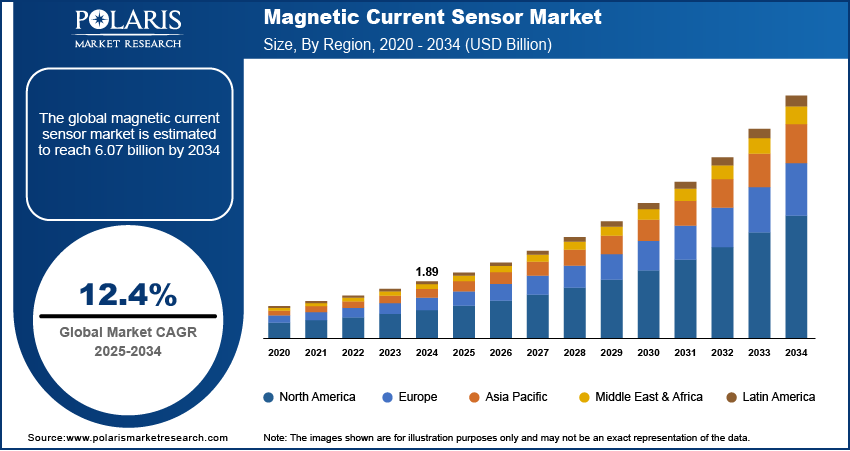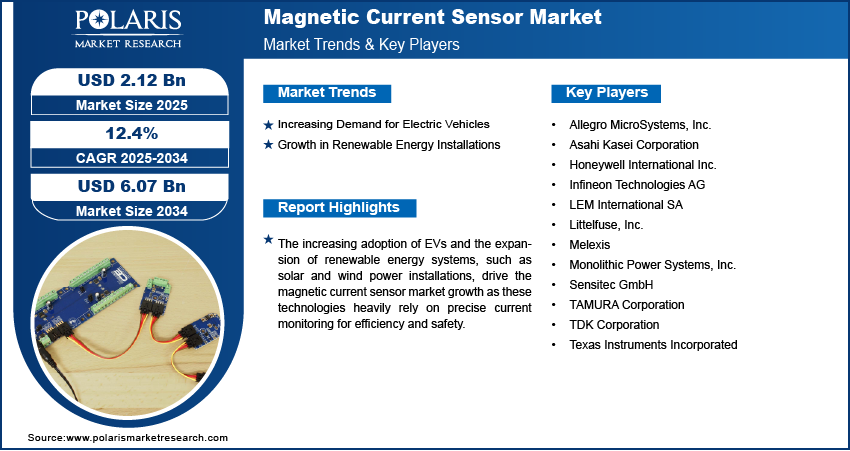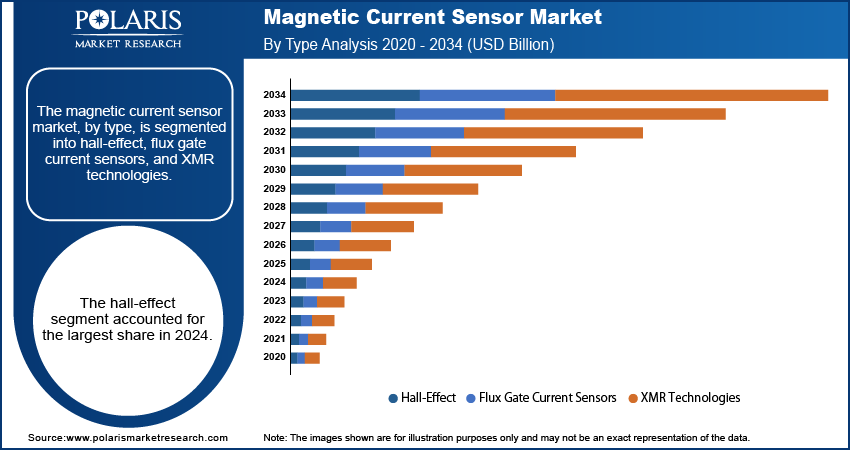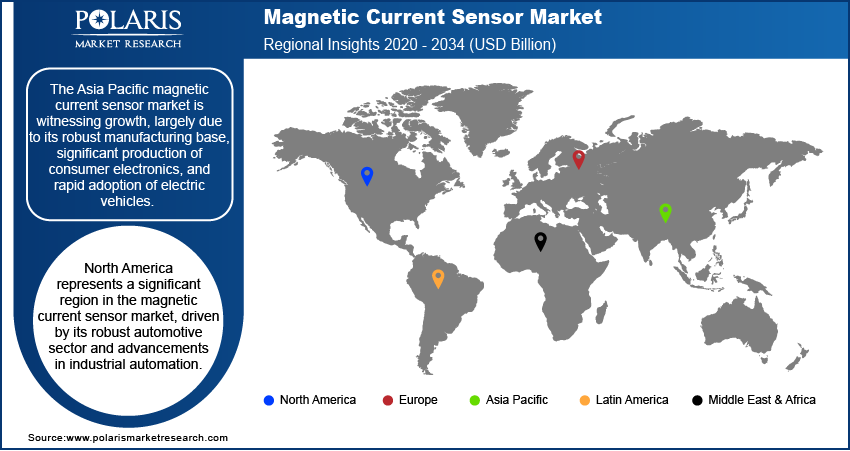
Magnetic Current Sensor Market Size, Share, Trends, Industry Analysis Report
By Type (Hall-Effect, Flux Gate Current Sensors, XMR Technologies), By Loop Type, By Industry, By Region – Market Forecast, 2025–2034
- Published Date:Jul-2025
- Pages: 118
- Format: PDF
- Report ID: PM6021
- Base Year: 2024
- Historical Data: 2020-2023
Market Overview
The global magnetic current sensor market size was valued at USD 1.89 billion in 2024 and is anticipated to register a CAGR of 12.4% from 2025 to 2034. The magnetic current sensor segment is seeing significant growth due to the increasing adoption of electronic devices across various industries.
Key Insights
- By type, the hall-effect segment held the largest share in 2024 due to its established reliability, cost-effectiveness, and versatility in measuring both AC and DC currents without direct contact. These characteristics make them a preferred choice across various applications, including automotive and consumer electronics.
- By loop type, the open-loop segment held the largest share in 2024, mainly because of its simpler design, lower cost, and reduced power consumption. Its ability to accurately measure both AC and DC currents, along with galvanic isolation, makes it suitable for a wide array of applications where extreme precision is not the primary requirement.
- By industry, the automotive segment held the largest share in 2024, driven by the increasing integration of magnetic current sensors in electric and hybrid electric vehicles for critical functions such as battery management systems and motor control.
- By region, Asia Pacific held the largest share in 2024, largely due to its robust manufacturing base, significant production of consumer electronics, and rapid adoption of electric vehicles. North America represents a significant region, driven by its robust automotive sector and advancements in industrial automation.

To Understand More About this Research: Request a Free Sample Report
Magnetic current sensors are crucial devices that monitor electric current in real-time, converting the magnetic field produced by the current into an electrical signal. These sensors are widely used in applications where precise, reliable, and compact current monitoring is essential for performance and safety.
The increasing proliferation of the Internet of Things (IoT) and smart devices is a significant driver of the industry growth. These sensors are crucial in IoT devices for power management, battery monitoring, and ensuring efficient energy use in a wide range of applications, from smart home appliances to wearable technology. As devices become smaller, more connected, and require longer battery life, the demand for compact, low-power, and highly accurate current sensors rises.
The continuous evolution and expansion of factory automation across industries represent another major driver. In automated manufacturing environments, these sensors are vital for precise control of robotic systems, motor drives, and various industrial machinery. They provide critical feedback for current monitoring, overload protection, and energy management, ensuring the smooth and safe operation of complex automated processes.
Industry Dynamics
- The increasing use of electronic gadgets in various fields drives demand for magnetic current sensors for power management and control.
- The rapid growth of electric vehicles necessitates magnetic current sensors for essential functions such as battery management and motor control.
- The expansion of solar, wind, and other renewable energy systems requires magnetic current sensors for efficient power conversion and grid integration.
- The ongoing progress in factory automation and robotics increases the need for magnetic current sensors for precise machine control and energy monitoring.
Increasing Demand for Electric Vehicles: The global push toward sustainable transportation has significantly boosted the demand for electric vehicles (EVs). Magnetic current sensors are vital components in EVs, playing a critical role in various systems such as battery management systems (BMS), motor control, and charging infrastructure. These sensors ensure accurate current measurement, which is essential for optimizing battery performance, extending battery life, and guaranteeing the safety of the vehicle.
According to the International Energy Agency (IEA) in their 2025 "Global EV Outlook" report, global electric car sales continued their strong upward trend, with more than 10 million units sold in 2024, and projections indicating 14 million units in 2025. This consistent growth in EV sales directly translates into a higher demand for magnetic current sensors, which are fundamental to the operation and safety of these vehicles.
Growth in Renewable Energy Installations: The global shift toward cleaner energy sources is leading to a substantial increase in renewable energy installations, such as solar and wind power. Magnetic current sensors are crucial in these systems for efficient power conversion, grid integration, and fault detection. They help monitor the current flow within inverters, charge controllers, and grid connection points, ensuring optimal energy harvesting and system stability.
As reported by the International Renewable Energy Agency (IRENA) in their 2025 "Renewable Capacity Statistics" report, global renewable energy capacity continued its rapid expansion, adding over 300 GW in 2024. This ongoing global commitment to increasing renewable energy generation capacity creates a sustained demand for magnetic current sensors, as they are integral to the efficient and safe operation of these green energy systems, thus propelling growth.

Segmental Insights
Type Analysis
Based on type, the segmentation includes hall-effect, flux gate current sensors, and XMR technologies. The hall-effect segment held the largest share in 2024. These sensors operate on the principle of the hall-effect, where a voltage difference is generated across a conductor when a magnetic field perpendicular to the current flow is applied. This characteristic makes them highly versatile for measuring both AC and DC without direct electrical contact, which enhances safety and minimizes power loss. Their widespread adoption is attributed to their reliability, cost-effectiveness, and established presence in diverse applications, particularly within the automotive sector for battery management systems and motor control, and in various industrial and consumer electronics products.
XMR (magnetoresistance) technologies segment is anticipated to grow at the highest growth rate during the forecast period. These advanced sensor types offer superior sensitivity, lower power consumption, and better immunity to stray magnetic fields compared to traditional Hall-Effect sensors. The rising demand for high-precision and compact current sensing solutions in emerging applications, such as advanced driver-assistance systems (ADAS), complex industrial automation, and highly integrated consumer electronics, is driving the rapid expansion of the XMR segment.
Loop Type Analysis
Based on loop type, the segmentation includes open-loop and closed-loop. The open-loop segment held the largest share in 2024. Open-loop sensors are generally simpler in design, more cost-effective, and offer lower power consumption, making them a popular choice for various applications where high precision is not the absolute critical factor. Their ability to measure both AC and DC currents, along with providing galvanic isolation, makes them suitable for a wide range of uses, including battery-powered circuits, basic industrial automation, and consumer electronics. The ease of integration into existing systems and their compact size further contribute to their widespread adoption, particularly in applications where space and cost are significant considerations.
The closed-loop segment is anticipated to register the highest growth rate during the forecast period. Closed-loop sensors, also known as "zero-flux" sensors, offer superior accuracy, linearity, and faster response times due to their feedback mechanism that compensates for the magnetic field. This higher performance makes them indispensable for demanding applications where precise current measurement and stability are paramount, such as in electric vehicle powertrains, advanced industrial control systems, and renewable energy infrastructure. As industries increasingly move toward higher efficiency, greater automation, and more stringent safety standards, the advanced capabilities of closed-loop sensors are becoming more vital, driving their accelerated adoption and market expansion.
Industry Analysis
Based on industry, the segmentation includes automotive, consumer electronics, telecom & networking, healthcare, industrial, energy & power, and others. The automotive segment held the largest share in 2024. This dominance is driven by the extensive integration of these sensors in modern vehicles for various critical functions. Magnetic current sensors are essential for electric vehicles (EVs) and hybrid electric vehicles (HEVs) in their battery management systems (BMS), motor control, and power inversion. Beyond electrification, they are used in traditional internal combustion engine vehicles for engine management, anti-lock braking systems (ABS), electronic power steering (EPS), and various safety features. The growing complexity of automotive electronics and the continuous drive for improved fuel efficiency, safety, and autonomous driving features ensure a sustained high demand for accurate and reliable current sensing solutions within this sector.
The industrial segment is anticipated to register the highest growth rate during the forecast period. This accelerated growth is primarily fueled by the increasing adoption of industrial automation, robotics, and the broader implementation of Industry 4.0 initiatives. In factories and manufacturing plants, magnetic current sensors are crucial for precise motor control, power management units, and predictive maintenance systems, ensuring optimal performance and preventing costly downtime. The expansion of smart factories, the need for enhanced energy efficiency in industrial machinery, and the growing complexity of automated processes are all contributing factors to the surging demand for highly accurate and robust magnetic current sensors in this sector.

Regional Analysis
Asia Pacific Magnetic Current Sensor Market Overview
The Asia Pacific magnetic current senser market accounted for the largest share in 2024. Asia Pacific is a dominant force in the magnetic current sensor, primarily due to its massive manufacturing capabilities and rapid industrialization. The widespread production of consumer electronics, coupled with the burgeoning electric vehicle market across several countries, significantly contributes to the high demand for these sensors. Additionally, increasing investments in renewable energy projects and smart infrastructure development are further propelling growth in this region.
China Magnetic Current Sensor Market Trends
China is a key country driving the magnetic current sensor market in Asia Pacific. As a global manufacturing hub for electronics and automotive components, China's vast production volumes directly translate into a high demand for current sensors. The country's aggressive push for electric vehicle adoption and its significant investments in renewable energy infrastructure, such as large-scale solar and wind farms, are major factors contributing to the rapid expansion and penetration of magnetic current sensors within its industrial landscape.
North America Magnetic Current Sensor Market Overview
North America represents a significant region in the global market, driven by its robust automotive sector and advancements in industrial automation. The widespread adoption of electric vehicles and the continuous development of smart grid infrastructure are key contributors to the demand for these sensors across the region. Additionally, the presence of major technology companies and ongoing research and development activities focused on sensor innovation further support expansion.
U.S. Magnetic Current Sensor Market Insight
In North America, the U.S. stands out as a pivotal country for the magnetic current sensor market. The nation's substantial investments in electric vehicle manufacturing, coupled with strong growth in renewable energy projects, particularly solar and wind, fuels the need for high-performance current sensors. The U.S. also boasts a technologically advanced industrial sector that heavily utilizes automation and robotics, requiring precise current monitoring solutions for efficient operations.
Europe Magnetic Current Sensor Market Outlook
Europe is a prominent region in the magnetic current sensor market, characterized by its strong commitment to sustainability and advanced manufacturing. The region's ambitious targets for reducing carbon emissions and its widespread adoption of electric mobility are significant drivers for the demand for current sensors in electric vehicles and charging infrastructure. Furthermore, Europe's well-established industrial base, with a focus on high-precision engineering and automation, consistently requires sophisticated current sensing technology.
The Germany magnetic current sensor market is a leading economy within Europe and plays a crucial role in the growth. The country's strong automotive sector, particularly its focus on premium and electric vehicle manufacturing, creates substantial demand for these sensors. Germany is also at the forefront of industrial automation and Industry 4.0 initiatives, where magnetic current sensors are vital for monitoring and controlling complex machinery and production processes.

Key Players and Competitive Insights
The magnetic current sensor market features a competitive landscape with several major players vying for share. Companies such as Allegro MicroSystems, Inc.; Infineon Technologies AG,; TDK Corporation; Asahi Kasei Corporation (AKM Semiconductor, Inc.); LEM International SA; Melexis; and Honeywell International Inc. are significant participants. The competitive environment is shaped by continuous innovation in sensor technologies, focusing on improved accuracy, miniaturization, and integration capabilities. Companies are investing in research and development to offer advanced solutions, particularly in Hall-Effect and XMR technologies, to cater to the evolving demands of various industries. Strategic partnerships and product launches tailored for specific applications, such as electric vehicles and industrial automation, are common strategies employed by these players to strengthen their position.
A few prominent companies include Allegro MicroSystems, Inc.; Infineon Technologies AG; TDK Corporation; Asahi Kasei Corporation (AKM Semiconductor, Inc.); LEM International SA; Melexis; Honeywell International Inc.; Texas Instruments Incorporated; TAMURA Corporation; Sensitec GmbH; Littelfuse, Inc.; and Monolithic Power Systems, Inc.
Key Players
- Allegro MicroSystems, Inc.
- Asahi Kasei Corporation (AKM Semiconductor, Inc.)
- Honeywell International Inc.
- Infineon Technologies AG
- LEM International SA
- Littelfuse, Inc.
- Melexis
- Monolithic Power Systems, Inc.
- Sensitec GmbH
- TAMURA Corporation
- TDK Corporation
- Texas Instruments Incorporated
Industry Developments
January 2025: Allegro MicroSystems launched two new current sensor ICs, the ACS37030MY and ACS37220MZ, optimized for accurate current sensing in compact and robust packages.
November 2024: LEM unveiled the CDT series, the first automotive-grade Type B Residual Current Monitoring (RCM) sensors for bi-directional On-Board Chargers (OBCs).
Magnetic Current Sensor Market Segmentation
By Type Outlook (Revenue – USD Billion, 2020–2034)
- Hall-Effect
- Flux Gate Current Sensors
- XMR Technologies
By Loop Type Outlook (Revenue – USD Billion, 2020–2034)
- Open-Loop
- Closed-Loop
By Industry Outlook (Revenue – USD Billion, 2020–2034)
- Automotive
- Consumer Electronics
- Telecom & Networking
- Healthcare
- Industrial
- Energy & Power
- Others
By Regional Outlook (Revenue-USD Billion, 2020–2034)
- North America
- US
- Canada
- Europe
- Germany
- France
- UK
- Italy
- Spain
- Netherlands
- Russia
- Rest of Europe
- Asia-Pacific
- China
- Japan
- India
- Malaysia
- Suth Korea
- Indnesia
- Australia
- Vietnam
- Rest of Asia-Pacific
- Middle East & Africa
- Saudi Arabia
- UAE
- Israel
- Suth Africa
- Rest of Middle East & Africa
- Latin America
- Mexic
- Brazil
- Argentina
- Rest of Latin America
Magnetic Current Sensor Market Report Scope:
|
Report Attributes |
Details |
|
Market Size in 2024 |
USD 1.89 billion |
|
Market Size in 2025 |
USD 2.12 billion |
|
Revenue Forecast by 2034 |
USD 6.07 billion |
|
CAGR |
12.4% from 2025 to 2034 |
|
Base Year |
2024 |
|
Historical Data |
2020–2023 |
|
Forecast Period |
2025–2034 |
|
Quantitative Units |
Revenue in USD billion and CAGR from 2025 to 2034 |
|
Report Coverage |
Revenue Forecast, Competitive Landscape, Growth Factors, and Industry Insights |
|
Segments Covered |
|
|
Regional Scope |
|
|
Competitive Landscape |
|
|
Report Format |
|
|
Customization |
Report customization as per your requirements with respect to countries, regions, and segmentation. |
FAQ's
The global market size was valued at USD 1.89 billion in 2024 and is projected to grow to USD 6.07 billion by 2034.
The global market is projected to register a CAGR of 12.4% during the forecast period.
Asia Pacific dominated the share in 2024.
Key players include Allegro MicroSystems, Inc.; Infineon Technologies AG; TDK Corporation; Asahi Kasei Corporation (AKM Semiconductor, Inc.); LEM International SA; Melexis; Honeywell International Inc.; Texas Instruments Incorporated; TAMURA Corporation; Sensitec GmbH; Littelfuse, Inc.; and Monolithic Power Systems, Inc.
The hall-effect segment accounted for the largest share in 2024.
The closed-loop segment is expected to witness the fastest growth during the forecast period.
